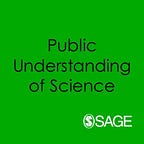The Cultural Authority of Science: Comparing Across Europe, Asia, Africa, and The Americas
Book review by Gordon Gauchat
Nearly a decade ago, I published a paper in Public Understanding of Science on the cultural authority of science that sparked a rediscovery of a research programme long in abeyance, tracing back to Robert Merton and his student and my mentor Thomas Gieryn. In the landmark work, The Cultural Authority of Science: Comparing Across Europe, Asia, Africa, and The Americas, this idea is developed and expanded to span the globe.
It is difficult to overstate the prescience of this book. In short, this is essential reading for anyone studying science communication, public perceptions of science, and cultural authority more broadly. Few issues express its imperativeness like climate change. Currently, the brilliant rainforest green of the Amazon has given way to ash and embers; there is a new landscape of brown tree stumps and grey smoke evocative of the First World War. The grave and accelerating effects of climate change also echo the daily futility likely experienced in 1916.
At present, world leaders perennially fail, hardening cynicism about our capacity for self-governance, reason, and knowledge. Moreover, growing polarization around climate science (and science generally) makes building the political coalitions necessary to meet this challenge seem impossible. Many global citizens are either unable to recognize the scale and scope of the crisis or are resigned to fate.
The Cultural Authority of Science begins with a brilliant conceptual overview, well-grounded in social scientific theory spanning sociology, political science, science communications, epistemology and ethics. Here, the authors provide the connecting fabric for the set of empirical studies that follow. The empirical research making up the core of the book includes data from every corner of the globe. This contribution is considerable because there is so little research on perceptions of science outside Western Europe and the US.
The empirical chapters also use a variety of data and methods to address the core issues in the book: 1) how to measure the cultural authority of science across cultural contexts and 2) how science perceptions change over time. Especially interesting is the use of mass media data to study the intensity of science coverage and the themes or images of science in that coverage. Linking these cultural representations to public opinion research is an essential direction moving forward.
The book’s empirical chapters also demonstrate the power of mixed methods. For example, the chapter on Korea moves beyond evaluative perceptions of science, such as GOOD/BAD or TRUST/THREAT, toward indicators of “consequentiality”. This important dimension compliments research in social psychology that suggests three atomic qualities in cultural meaning, including PASSIVE/ACTIVE and POWERFUL/WEAK. The distinctions found in surveys is insufficient knowledge without understanding the “frames and representations” of science in the public sphere. The chapter on ‘Framing Science’ provides an excellent baseline for future research on this topic and will reveal potential contrasts that have yet to occur to researchers.
As mentioned, the book’s definition of cultural authority provides a unifying concept for future research spanning disciplinary and methodological boundaries. Science’s cultural authority, the volume’s editors posit, is a social fact germane to any society and represents an institution’s capacity to “speak truth to power”. This reasonably encapsulates the constellation of issues we currently face. Still, some elements need further elaboration and refinement.
I began using “cultural authority” around 2008 to describe a cultural disposition toward science in the public sphere — the myriad audiences or publics that experience scientific knowledge and organised science (i.e. science’s organisational network). I further proposed that science’s cultural authority was heterogenous because “publics” experience science differently depending on their position in society (i.e. race, class, gender, education, age, political orientation). To put it another way, I defined science’s cultural authority qua society’s perception of it: attributions, expectations, and confidence in this institution. However, my account only rediscovers the work of Robert Merton and Thomas Gieryn.
It is surprising that Merton is scarcely mentioned in this volume. Merton first discussed science’s “cultural authority” in 1937. A few short years later, he wrote, “difficult as the very notion may appear to those reared in a culture which grants science a prominent if not commanding place in the scheme of things, it is evident that science is not immune from attack, restraint, or repression”. For Merton, the core theoretical problem was science’s authority in the face of fascism, McCarthyism and evangelical political mobilization.
Gordon Gauchat is Associate Professor of Sociology at University of Wisconsin — Milwaulkee, with recent publications on issues of trust, legitimacy, politics and public acceptance of science. He wrote on The Cultural Authority of Science: Public Trust and Acceptance of Organized Science in Public Understanding of Science, 20(6), 751–770.
